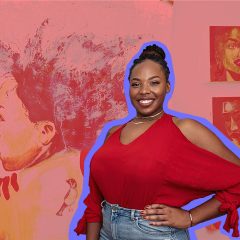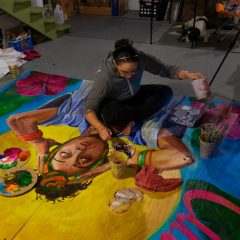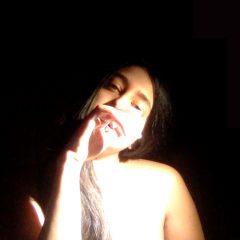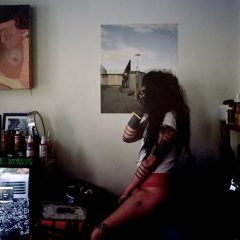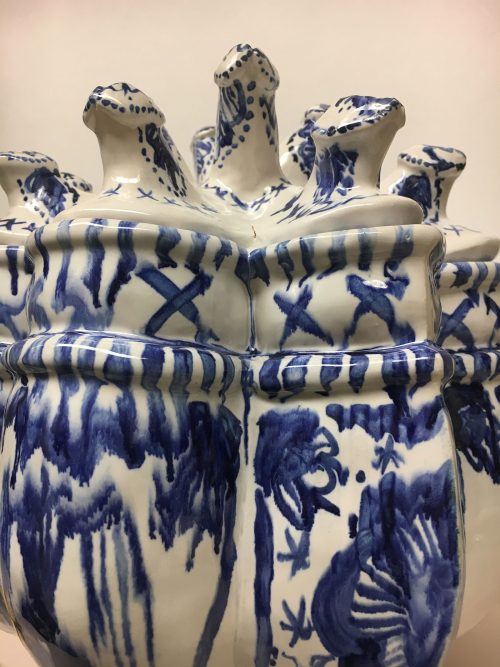
I enter Little Berlin, after a meandering walk through a former industrial site, at a higher elevation, as the gallery sits below ground level. This has the advantage, as one descends the stairs, of giving a clear sense of the space.
Despite being in an exhibition from a specific place, the works on view quickly assert the figure, the body, the person. The body recurs in nearly every work included, whether in the flesh toned elements in Emily Bayless’s “Trifling” (2019) or the repeated penises in her historically referenced “Toolipiere” (2019) Victoria Kue’s humorous take of female experience in textiles and in paint, or cemented in the horror-like story told in James Hollenbaugh’s black and white video “Toilet Tale” (2018).
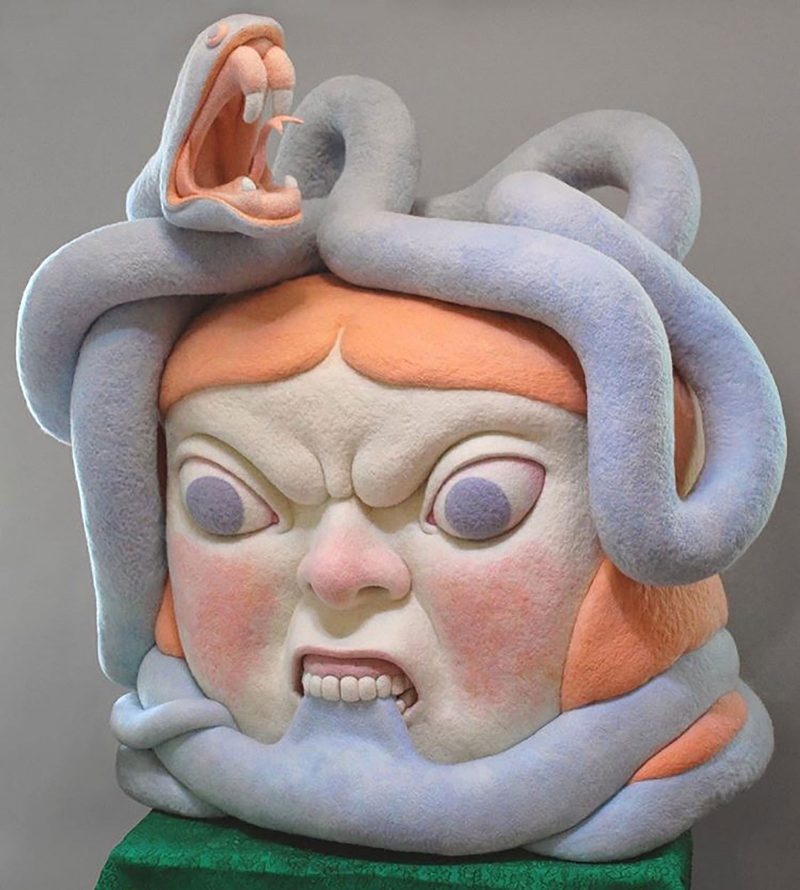
The curious and surprising sculptural work of Paolo Puck is worth the trip to the gallery. The cartoon-like “Sophia and the Snake” (2016), essentially a large-scale head covered in pastel shades of felting, is an image of female power. A snake, twisting around a female head is caught tightly in her biting down teeth. Humorous and concise, it’s real meaning might be missed or construed as some childhood fantasy. Yet a little digging reveals a complex theme from gnostic mysticism about knowledge and power, the Garden of Eden and who really ate the apple. Puck’s Sophia is worth seeing and reading up on.
Other notable figural works in the show include Osmyn Oree’s “Uncle Fred” (2018), a powerful portrait of an older black man, one of two large-scale photographs included in the show that ask the viewer to see figures as people through the height each is shown at; and Salina Almanzar’s especially deft “retablos”, small devotional images, are both beautifully made and focused on the archetypical, yet personal nature of her tales of family life. In “Con la música por dentro Abuelo”, (2019), and “Nuyorican Mama”, (2019), two of four included in the show, we glimpse the beatification of household saints. To the right of these works are, Mike Benvenia’s sculpture “Physical Therapy” (2017), made of found materials, stands against and away from the wall like two figures teetering on the edge.
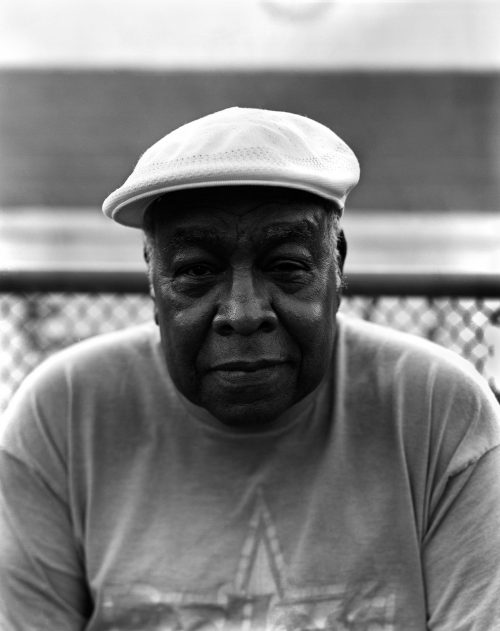
Standing out by its scale and by being non-figural, yet still very much about the body is Arthur Oak Padelsky’s “Red Flag” (2019), an overwhelming red banner, covered in almost illegible text, like a curtain shrouding the entire wall, this work signals alarm simply by its color. The alarm is real. Padelsky gives voice to all the red flagged horror found on the Internet and the red flags our own stories may raise for others.
I am a fan of any exhibition that includes reading material, yet in this case the curated collection of literature and zines from Lancaster assembled by Tyler Barton and Erin Dorney’s feels awkward and mildly inaccessible mostly because they are on high shelves, but also as there is nowhere to sit and digest the notable selections, which demonstrate the depth of creative practices in Lancaster
.
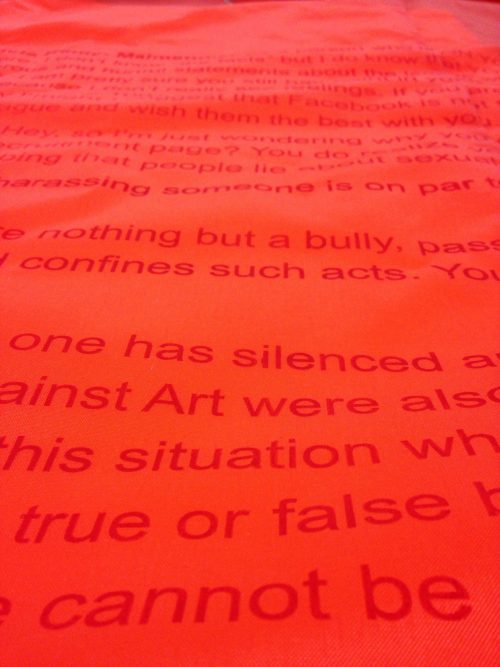
Certainly, there is power in place. In our mind’s eye we easily conjure an image of Lancaster, Pennsylvania, a place that is widely defined by its fertile landscape and a specific culture that has tilled that soil. That image is, I would wager, populated with Amish families and horse drawn buggies, an unsettling thing to encounter in the real if you haven’t before. However, the city of Lancaster is ethnically diverse and has drawn upon the richness of its population to sustain a thriving haven for creatives and other entrepreneurs, amid the Amish farms and tourism that they attract, demonstrating that a city is only as good as its people.
Gepfer’s curatorial statement makes clear that this exhibition is a tribute to all the young, contemporary artists that strive to make art and make it, while living and working in Lancaster. Gepfer’s goal is to raise the profile of those whose works reach beyond the landscape it is made in, by voicing real concerns and making important statements. If there is a defining feature of this exhibit it is its inclusivity, evident in the eclectic set of methods, materials, and messages. Such variety may be deemed a weakness in a curated show, but Gepfer makes clear that this exhibition is intended to give a taste, correct the record a bit, and stake out territory for Lancaster that might otherwise go unrecognized outside that city.
One thing that has me confused is the title of the exhibition. Lancaster is quaint, but the work in this exhibition is not. For as much as the curator, Henry Gepfer, acknowledges this and the gravity of the selected works on view, his title has the effect of countering, even undermining the power embodied in the exhibition. Quaint is too pejorative a title for a show of artists whose works are resonant and worth seeing.
Quaint is at Little Berlin, 2430 Coral St., until April 28, 2019, and is curated by Henry Gepfer and includes works by Salina Almanzar, Tyler Barton and Erin Dorney, Emily Bayless, Mike Benvenia, James Hollenbaugh Victoria Kue, Osmyn Oree, Arthur Oak Padelsky and Paolo Puck.
Bio
Julia Marsh is an artist and writer living and working in Philadelphia since last summer. She recently became the Gallery Director at Rider University in Lawrenceville, NJ. She is also the President-elect for the Women’s Caucus for Art.


